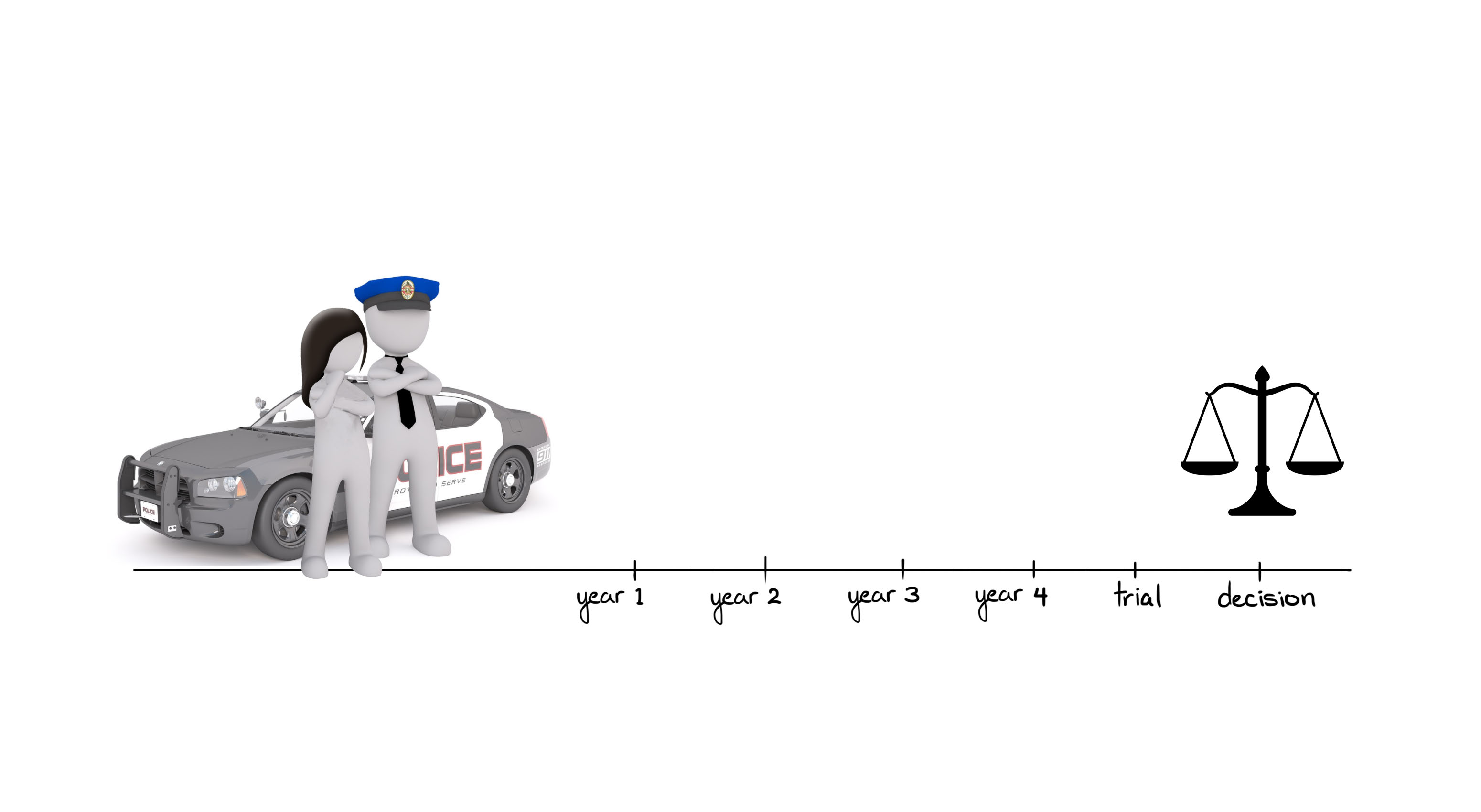Accused Gee-Gees walk free during four-year wait for trial, but what about the survivor and the public at large?
In the summer of 2016 the Supreme Court of Canada, in the case of R. v. Jordan, made dramatic changes to the framework governing the right to criminal trial within a reasonable period.
Barrett Jordan is from Surrey, British Columbia., and while facing drug charges had spent four years in prison awaiting his trial. Once the Supreme Court ruled this wait length unconstitutional, Jordan’s charges were stayed, and it was a victory for him and others detained for unjust lengths of time.
The implications of this ruling are clearly beneficial for the accused. However, when the ruling came out, there was some media hysteria around the implications for the victims involved. If an alleged criminal was released before trial, how could families move on from tragedy with no justice served?
While this is a legitimate concern, the discussion seemed to miss an important point—less time until trial is more often than not a very good thing for the complainant, as much so as the accused.
But as seen in the recent sexual assault case involving two Gee-Gees hockey players, the benefits afforded to the complainant do not always come easily.
Because the defence chose to request adjournment twice before the trial, there was a four-year wait until the court date. And so, during this extra time, alleged perpetrators of sexual assault walked free.
The survivor then has to cope with the consequences of having their alleged rapists walk free for four years before facing charges in court. This scenario, for many survivors beyond this one case, can be a nightmare.
Detention vs. freedom
With the Gee-Gees trial recently having wrapped up, I spoke with lawyer David Butt, who explained that in most cases the accused will walk free.
“There’s a presumption, automatically, for most cases you’ll be out of jail while waiting for your trial. Before trial, you could be innocent,” he noted. “So we could ask ourselves, why should somebody go to jail if they’re innocent?”
However, he emphasized three factors that the court will consider when determining if someone should be detained until trial, including the likelihood the person will show up for their court date, whether they are perceived to be a risk for repeat offences, and impact on public interest.
While the first two considerations are mostly straightforward, Butt explained that public interest considerations will vary based on the case.
“Courts are delivering a public service, justice is a public good. And we always want the path to work to maintain confidence of the public in the justice system,” he said.
“That actually can take us both ways. So for example, if you have a kid from a good family, is charged with a crime, isn’t going to run away, doesn’t have any prior record, the trial is a year away. If you held that kid in jail for a year, the public would be outraged,” said Butt.
“On the other hand, if you had someone who committed a horrible, violent murder, and it shocked the community, this killing, having someone like that wandering the streets before trial, chances are that the public would be outraged.”
Although Butt isn’t familiar with the former Gee-Gees personally, he was confident in guessing that they are unlikely to be a flight risk and probably don’t have long criminal records. With such a long wait until the trial, he says if they were detained immediately after their arrest they might have even served more time than if they were convicted.
“So that’s why they’re out before trial. And that’s generally the case with sexual assault.”
The cost of playing the waiting game
Public educator Julie Lalonde often hears in her workshops that false accusations ruin the lives of the accused. She says this is true, but also emphasizes that reputational damage from sexual assault and harassment allegations definitely affects both parties involved.
She brings up the Gregory Alan Elliott case, a 2016 trial that gained national attention after Steph Guthrie and other women accused Elliott of online harassment.
“Between the trial date and the sentence date, you had people like Christie Blatchford writing these long op-eds about how Stephanie Guthrie was a man-hater, she was offended by everything, and then people like Joe Rogan took it up,” Lalonde says.
“So whether or not Gregory Alan Elliott ever got convicted, which he didn’t, it doesn’t change the fact that her life will never be the same because the public conversation about her went on for so long that now it’s forever attached to her name.”
She notes that the public discourse around sexual assault accusations in particular can be particularly damaging to the victim, as it tends to follow a trajectory of suspicion and doubt.
“We’re so quick to frame sexual assault victims as liars,” she says. “So we believe that if someone hasn’t been convicted it’s innocent until proven guilty, and you’re just smearing a good man’s name. That pressure hangs over your head.”
Lalonde emphasizes that this effect is not limited to victims in the public eye, but extends to sexual assault survivors who are unnamed, as seen in the Gee-Gees case.
“(Unnamed) women can’t speak out and defend themselves because they either don’t want to be named or it’s seen as damaging to your case, so you have to sit back and watch your life get torn apart in the public eye. And you have to just sit there and watch it happen.”
In addition to the pressure of public speculation, women who are named publicly can face harsh penalization for sharing their stories with the press pre-trial. Lalonde brings up the Ghomeshi case as a good example, with the defence in this case using actress Lucy DeCoutere’s communication with the media as a way to argue that she was only accusing Ghomeshi for attention.
“That’s a lie that the judge bought, and argued. That they were not victimized, they were not traumatized because they were more than happy to think about the media, you wouldn’t do that if you were traumatized by something.”
Aside from costs to reputation, there’s also a price to pay when it comes to memory of the incident itself.
When new information about the allegations of sexual misconduct against former Conservative Party leader Patrick Brown came out, specifically that one alleged victim had realized she reported the wrong age during her first recount of the story and corrected it, Brown tried to leverage this in the public eye to prove that the alleged misconduct never happened.
According to Lalonde, this focus on poking holes in a complainant’s story by pointing out small, usually irrelevant, misremembered situational elements just demonstrates a misunderstanding of the neurobiology of trauma.
“We have these ridiculous assumptions about what trauma looks like, which includes the fact that yeah if you’re able to stand up for yourself, then you’re clearly not traumatized. If you don’t remember everything in perfect chronological order the first time it’s asked, you don’t say the same thing over and over again every time then you’re lying,” Lalonde explains.
“But a fact that we know to be true is that the brain tries to protect us from traumatic experiences.”
She likes to use the example of experiencing a car accident for easy comparison.
“Do you remember everything in exact chronological order? Do you remember what you were wearing, do you remember what the people in the car were wearing? Or do you remember bits and pieces, but you can’t necessarily put them in the right order? Are there some things that you remember very vividly, but others you only know because you were told about it after the fact? That’s what trauma does to memory.”
“So once again the longer these cases go on, the more people have time to speculate, and they have time to go on their own conclusions about ‘oh this is obvious, and she’s lying.’”
Supporting survivors pre-trial
When it comes to legal safeguards put into place for the survivor of a sexual assault, Butt says that the courts aim to create distance between the accused and the complainant both physically and socially.
“The vast majority of sexual assaults are not committed by strangers jumping out of the bushes. They’re committed by people who know the victim,” he explains. So very often you have accused people who, apart from the allegations … are pro-social people with roots in communities.”
Given the nature of the typical accuser’s relationship to the victim and the community, Butt says that there are several typical measures taken to create the necessary distance.
First of all, it is standard that the accused person is ordered by the court to have no contact, which covers any means of communication.
“That means both direct and indirect contact. So you cannot text, or call, or email or do anything like that to the complainant directly. But you also cannot get a friend to contact the complainant, and say ‘this is what the accused wants to say to you.’”
He notes that in domestic violence cases it’s quite common for the complainant to contact the alleged perpetrator, but even then the onus is on the defendant to not communicate and the same penalties apply.
Another routine measure is creating a geographical boundary that the accused may not enter.
“They would typically be not to be within 50 metres, 100 metres, 500 metres … not to be within that distance of any place where the accused person knows that the complainant is likely to be. Or they might be more specific and say, may not be at a certain address, and that might be where the complainant lives or works or goes to regularly.”
Butt says these conditions are strict, and if the accused breaches any of them they can be charged with a separate criminal offence, and risk having their original bail pulled and returning into custody.
“They can be convicted, and very often do go to jail. And what’s interesting is that you can be convicted of that even if you’re acquitted of sexual assault.”
He notes that apart from standardized conditions, the court can also impose orders that are specific to the case at hand.
“For example, curfews if they tend to prowl at night. If alcohol was part of the offence, maybe no alcohol. Or if the offence involves minors, not to be in the company of any person under age 18.”
Lalonde highlights shortcomings in this setup, since incidences of rape and sexual assault commonly occur in a date setting, but a ‘no dating’ condition wouldn’t be a practical rule to enforce.
“If we understand the dynamic of sexual violence, it’s about power and control,” she says. “someone who commits date rape, to use that language, is a risk to other women.”
Minimizing cost, maximizing benefit
At the end of the day, Butt says that the goal is to have measure that are “more individualized to the circumstances of the allegation, but also the individualized circumstances of the accused person too,” and to “try and manage the risk in a community as much as possible.”
He says part of the reason why court hearings are public is so that the community at large knows there’s an issue, which can empower the public to know whether they should intervene and call the police if the accused is seen breaching their conditions.
Lalonde believes that everybody benefits from us finding a way to speed up this process, both the defendant and complainant, but one side gets talked about in this context less than the other.
“People just look at it from the side of the accused, and they don’t look at it from what does it do to the victim to have this process dragged on.”





